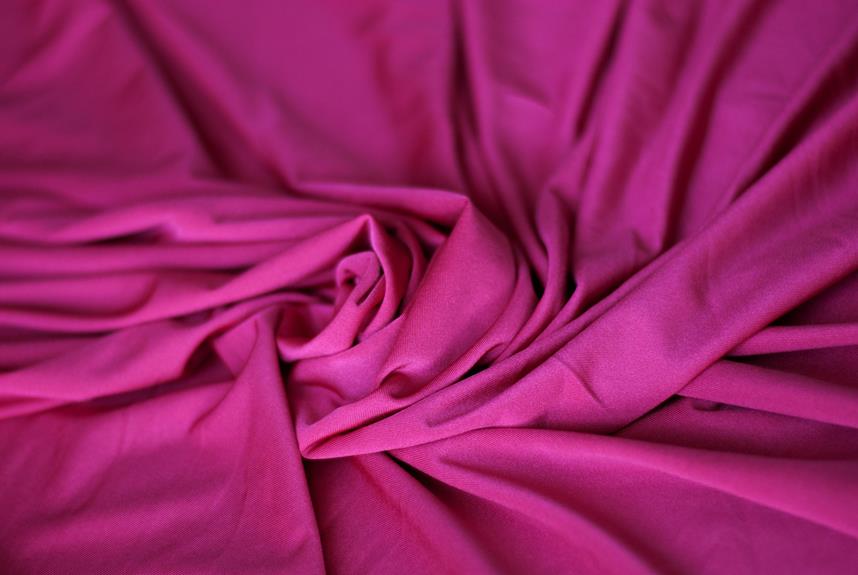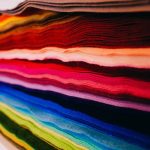When you're choosing between batiste and broadcloth, it's essential to understand their distinct qualities. Batiste's lightweight and breathable nature makes it ideal for warm weather, while broadcloth's durability and smooth texture suit tailored garments. Each fabric has its unique applications, influencing how a garment will look and feel on you. As you consider your options, think about the specific needs of your project—are you leaning towards something airy and soft, or do you prefer a crisp, structured finish? The decision might be more complex than it seems.
Table of Contents
Overview of Batiste
Batiste is a lightweight, finely woven fabric that's known for its soft feel and delicate drape, making it a popular choice for garments like blouses and dresses. You'll appreciate how its airy texture allows for breathability, perfect for warm weather. Often made from cotton or a cotton-linen blend, batiste provides a comfortable fit against your skin.
When you work with batiste, you'll find it easy to sew, as it doesn't fray easily and holds up well during construction. Its smooth surface allows for clean stitching, which is crucial when you're crafting intricate details. The fabric's subtle sheen can elevate your creations, giving them a delicate and elegant appearance.
Batiste is also versatile. You can use it for lining, making it an excellent choice when you want a lightweight layer in jackets or skirts. Plus, it's suitable for a variety of styles, from casual to dressy.
If you're aiming for a sophisticated look without sacrificing comfort, batiste should be on your radar. So, whether you're designing casual wear or formal attire, consider incorporating this lovely fabric into your next project.
Overview of Broadcloth
Broadcloth is a tightly woven fabric known for its smooth texture and durability.
You'll often find it used in shirts, dresses, and various home textiles due to its versatile nature.
Understanding its composition and common applications will help you appreciate why it's a popular choice in the fabric world.
Fabric Composition and Texture
When it comes to fabric composition, broadcloth stands out for its tightly woven structure, which gives it a smooth and lustrous finish. This fabric typically consists of a blend of cotton and polyester, although you might find variations that include other fibers. The result is a material that not only looks polished but also offers durability and easy maintenance.
Here are three key characteristics of broadcloth's texture:
- Smoothness: The tight weave reduces friction, making broadcloth feel soft against your skin, ideal for comfortable clothing.
- Weight: Broadcloth is generally lightweight, which allows it to drape well while still holding its shape, making it versatile for various styles.
- Slight Sheen: The fabric's finish often has a subtle shine, adding a touch of elegance that enhances its overall aesthetic appeal.
With these features, broadcloth is a popular choice for those seeking a blend of style and practicality. Its fabric composition and texture make it a reliable option that can elevate any wardrobe.
Common Uses and Applications
You'll find broadcloth commonly used in a variety of applications, from dress shirts and blouses to lightweight jackets and home decor items like curtains and pillowcases.
Its smooth finish and crisp texture make it a favorite for garments that require a polished look. When you want to create a stylish, comfortable dress shirt, broadcloth is often your go-to choice, as it drapes well and resists wrinkling.
In addition to clothing, broadcloth is an excellent option for home decor. You can use it to make chic tablecloths, napkins, and even upholstery for furniture. The fabric's durability ensures that it holds up well under regular use, making it practical for everyday items.
Broadcloth also works well for crafting projects, including quilt backing and tote bags. Its versatility means you can easily find it in various colors and patterns, allowing you to personalize your creations.
Whether you're sewing for yourself or your home, broadcloth provides a reliable and stylish option that combines function with aesthetic appeal. So, when you're choosing fabrics, consider broadcloth for its numerous practical uses.
Texture Comparison
Batiste offers a soft, lightweight feel that contrasts sharply with the denser, smoother surface of broadcloth. When you touch batiste, you'll notice its delicate, almost airy texture, making it ideal for garments where comfort is key.
On the other hand, broadcloth feels sturdier and more structured, providing a polished appearance that works well for dress shirts and tailored pieces.
Here are three key texture differences to consider:
- Softness: Batiste's softness makes it perfect for layered clothing, like blouses and children's wear, while broadcloth's smoother surface gives it a crisp finish.
- Drape: Batiste drapes beautifully and flows gently, creating a relaxed look. Broadcloth, however, maintains its shape well, adding a more tailored silhouette.
- Finish: Batiste often has a slightly matte finish, which contributes to a more casual vibe. Broadcloth, with its fine weave, often has a subtle sheen that enhances its elegance.
Understanding these texture differences can help you choose the right fabric for your specific needs and style preferences.
Weight and Breathability
In terms of weight and breathability, batiste shines as a lightweight fabric that allows for excellent airflow, making it a top choice for warm-weather garments.
You'll notice that batiste feels airy against your skin, ensuring comfort during those hot, humid days. Its delicate weave contributes to its lightness, enabling you to wear it without feeling weighed down.
On the other hand, broadcloth is heavier, which can limit its breathability. While it's still a versatile fabric, you might find it less comfortable for summer wear, especially if you're sweating.
The tighter weave of broadcloth provides durability, but that comes at the cost of airflow.
Common Uses and Applications
When choosing between batiste and broadcloth, you should consider their popular applications in apparel and home textiles.
Batiste is often favored for lightweight clothing, while broadcloth is a go-to for shirts and linens.
Understanding these uses can help you make the right choice for your sewing projects.
Apparel and Clothing
For everyday wear, both batiste and broadcloth serve unique roles in creating comfortable and stylish garments.
Batiste's lightweight and breathable nature makes it perfect for warm weather attire, while broadcloth's durability and smooth finish lend themselves well to structured clothing.
Understanding their specific applications can help you choose the right fabric for your needs.
Here are three common uses for each fabric:
- Batiste:
- Ideal for summer blouses and dresses, as it allows for airflow and keeps you cool.
- Great for baby clothes, providing softness against delicate skin.
- Perfect for lightweight linings in garments, adding a touch of comfort.
- Broadcloth:
- Commonly used in dress shirts, offering a polished look that's suitable for both casual and formal settings.
- Works well for tailored suits, providing a crisp appearance that holds its shape.
- Excellent for casual pants or skirts, combining comfort with a refined style.
Home Textiles and Linens
Batiste and broadcloth aren't just for clothing; they also play significant roles in home textiles and linens, enhancing both comfort and aesthetics in your living space. If you're looking to elevate your home decor, consider using batiste for lightweight curtains or delicate table linens. Its soft, airy nature allows natural light to filter in while maintaining a sense of elegance.
On the other hand, broadcloth works wonderfully for more durable applications. You might choose broadcloth for bed linens, pillowcases, or duvet covers, thanks to its sturdiness and easy care. The fabric resists wrinkling, making it a practical choice for everyday use.
When it comes to decorative accents, both fabrics shine. Batiste can be used for soft throw pillows or light quilts, adding a touch of sophistication without overwhelming your space. Broadcloth, with its rich texture, can create statement pieces like upholstered furniture or vibrant wall hangings.
Incorporating these fabrics into your home isn't just about aesthetics; it's also about creating a cozy, inviting atmosphere that reflects your personal style. Choose wisely, and let your home textiles tell your unique story.
Care and Maintenance Tips
To keep your batiste and broadcloth fabrics looking their best, follow specific care guidelines tailored to each material. While both fabrics are delicate, they require different approaches to maintenance.
For batiste, which is lightweight and delicate, consider these tips:
- Gentle Washing: Hand wash or use a gentle cycle in cold water with mild detergent. Avoid bleach, as it can damage the fibers.
- Air Dry: Lay batiste flat to air dry or hang it on a padded hanger. Avoid wringing it out to prevent distortion.
- Low Heat Ironing: Iron on a low setting while the fabric is slightly damp to remove wrinkles without scorching.
Broadcloth, being sturdier, has its own care requirements:
- Machine Wash: You can safely machine wash broadcloth in warm water. Use a standard detergent.
- Tumble Dry: This fabric can handle a low tumble dry setting, making it easy to maintain.
- Medium Heat Ironing: Iron broadcloth on medium heat to keep it crisp and wrinkle-free.
Choosing the Right Fabric
Choosing the right fabric depends on your specific needs, from the weight and drape to the intended use of the garment. When you're deciding between batiste and broadcloth, consider what you want to achieve.
Batiste is lightweight and airy, perfect for delicate blouses, summer dresses, or linings. If you're aiming for a soft, flowy look, batiste might be your best bet.
On the other hand, broadcloth offers a sturdier structure, making it ideal for shirts, skirts, and even tailored garments. Its slightly heavier weight provides durability and a crisp finish, which can enhance the garment's overall shape.
Consider the climate too; batiste breathes well, making it suitable for warmer weather, while broadcloth's thickness can provide comfort in cooler temperatures.
Lastly, think about how you plan to care for your fabric. Batiste can require gentler washing methods, while broadcloth is generally more resilient.
Ultimately, understanding the characteristics of each fabric will help you make the best choice for your project. So, take your time, weigh your options, and select the fabric that aligns with your vision!
Frequently Asked Questions
What Are the Historical Origins of Batiste and Broadcloth Fabrics?
You'll find that batiste originated in France during the 14th century, while broadcloth emerged in medieval England. Both fabrics reflect their regions' textile craftsmanship, evolving over time to meet varying fashion and practical needs.
Are There Sustainable Options Available for Batiste and Broadcloth?
Yes, you can find sustainable options for both batiste and broadcloth. Look for organic cotton or recycled materials, which reduce environmental impact. Many brands now prioritize eco-friendly practices, making it easier to choose responsibly.
How Do Batiste and Broadcloth Compare in Terms of Cost?
When considering cost, you'll find batiste generally offers a more affordable option compared to broadcloth. However, prices can vary based on quality and brand, so it's worth shopping around for the best deals.
Can Batiste and Broadcloth Be Dyed Easily?
Both fabrics can be dyed easily, but batiste often absorbs color better due to its lightweight nature. You'll find that broadcloth may require more dye for a vibrant result, so choose accordingly!
What Are the Environmental Impacts of Producing These Fabrics?
When you consider the environmental impacts of fabric production, you'll find that both processes can lead to significant water usage and pollution. Sustainable practices are crucial for minimizing these effects and protecting our planet's resources.
- How Does Ring Spun Cotton Affect Garment Fit and Shape Retention? - August 13, 2024
- What Are the Challenges in Producing Ring Spun Cotton? - August 13, 2024
- Is Ring Spun Cotton Suitable for Plus-Size Clothing? - August 13, 2024







